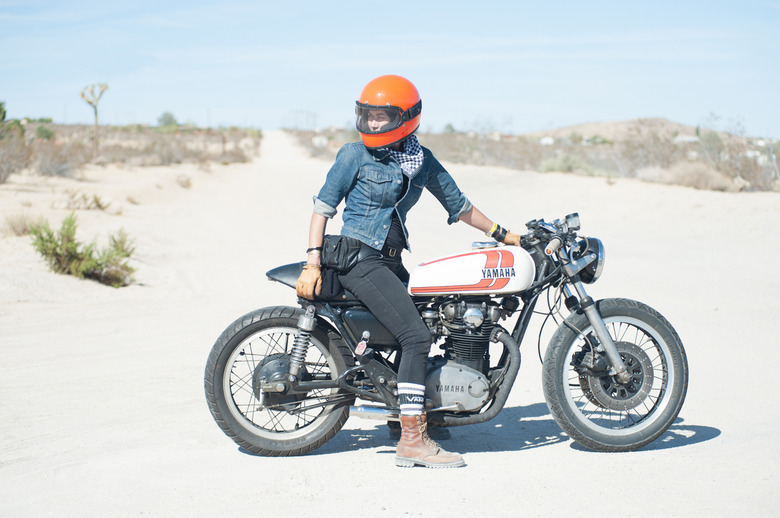Designer Jill Stevens Has Made A Career Out Of Taking The Unconventional Path
"As a social worker, I had no money," said Jill Stevens, founder and principal designer of Dust + Co., relaying old stories from a well-worn blue plaid couch in her Los Angeles living room. "I had to buy vintage and had to shop at thrift stores, and even now, I still don't buy anything new."
Based on decor alone, it's clear that every item within these walls has lived a past life. A crocodile head rests inside of a glass bookcase, vintage signage colors empty space, and blood orange throw pillows were repurposed from the interior of an old Camaro.
"Everything in this apartment has sort of found me over the years," she continued.
Like the items in her home, Stevens's design career also took years to formulate. Originally, Stevens worked as a social worker on child abuse cases in Savannah, Georgia, after previously being assigned to cases involving domestic and sexual assault. The work was tough, and the affects of a grueling schedule and dwindling county resources took a toll.
"I wanted to do my best service while I could, and then try out this other thing that I never really ever explored," she said.
So, Stevens moved back to her native L.A. and immersed herself in the design field. She worked as a full-time administrative assistant for a high-end architecture firm during the day, and at night, attended design classes in interior architecture at UCLA. "I became a LEED accredited professional at that time," she said. "I was the second person at the architecture firm to do so — the first was the principal, and the second was the receptionist."
It was a fast change for someone who didn't have as much experience as her coworkers, and she knew it. "I hustled," Stevens said, as a matter of fact. "It was a little bit difficult for them to accept that, so it was kind of funny, but I was stoked." She also used vacation time to take one day off per week and intern at a green interior firm, among the first of its kind, in Venice Beach.
That drive came in handy when the housing crash gutted the industry in 2008, and the firm made her role part-time. The entrepreneurial stirrings of what led to Dust + Co. emerged during these years, as she supplemented her income by selling wares under the same name.
"People weren't investing in their homes, but there was always commercial," she said.
In 2010, Stevens became a certified interior designer and joined a new firm that would shift her focus to commercial interiors. She found that she loved working on bars and restaurants, where people can return to again and again — as opposed to a "house that someone goes to for a weekend once a month," she said.
"I still come from that social worker wallet [mentality]," she went on. "So, I like working with mom-and-pop businesses primarily, or one-off restaurants, or retail spaces."
And yet, it wouldn't be entirely true to solely base Stevens's resourcefulness on her first career. A childhood spent in Los Angeles's Inland Empire, a homogenous landscape of endless stucco track housing and strip malls, had seared its imprint on the designer's core ethos, too. She comes from three generations of "garage sailors," which has nothing to do with maritime travel, it turns out. To this day, her family maintains a tradition of routine pilgrimages to nearby garage and estate sales.
"We weren't like the neighbors, we had weird [stuff] in our house that my mom found garage sailing...she was super practical, and frugal, and scrappy," Stevens remembers.
Individual objects bought second-hand and non-luxury materials are among top priorities for Stevens, and she tends to favor projects that can make a low impact. For her recent commercial project Da Kikokiko, a restaurant built atop wetlands and Native burial ground in a brand new complex, her combination of skills is put to good use. It's "basically a really nice strip mall," she said. "I wanted it to feel like you're in Hawaii, or some place other than a Playa Vista development."
It was a challenge that Stevens said required a lot of research. In the end, she decided to outfit the small space in variegated tiles, made mostly from recycled materials, and exposed wood.
That test to create something distinctive, the so-called "non-linear path" that Stevens often takes, is exciting for her. In keeping with her esoteric home and unconventional past, Stevens prefers calling her own shots to arrive at a cohesive design.
"For most of my work, 10 percent is the fun part and the other part is just figuring out solutions — that's probably 60 percent of it. The rest is trying to get [the project] built," said Stevens. "You never know what you're going to be thrown or what the solution is going to be, but there's always a solution."
